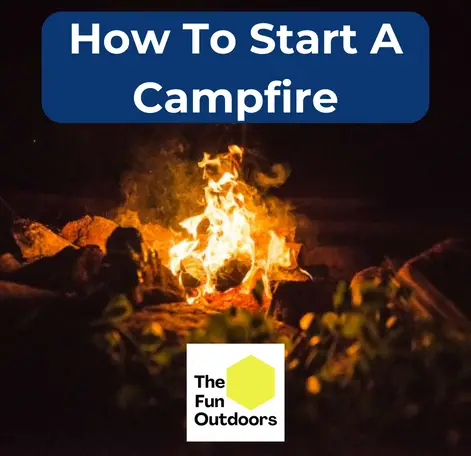Starting a campfire is an essential skill for anyone who enjoys spending time in the great outdoors. Whether you’re camping, hiking, or just enjoying a day trip, a campfire can provide warmth, light, and a place to cook food. However, starting a campfire can be intimidating if you’re not familiar with the process.
With the right materials, good preparation, and a little know-how from this guide, you’ll know how to start a campfire in no time.
Preparation for Starting a Campfire
Starting a campfire requires preparation to ensure a safe and enjoyable experience. Here are some essential steps to follow before starting a campfire.
Build A Fire Pit or Fire Ring
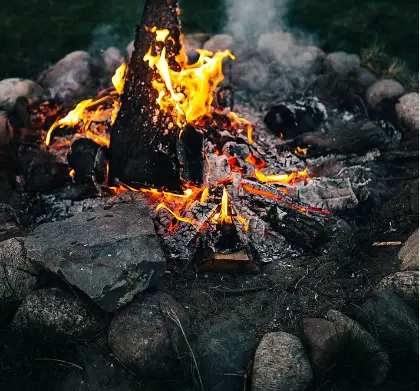
Building a fire pit or using a designated fire ring is crucial to prevent the spread of fire and protect the environment. Most campgrounds have a fire pit or fire ring, but if there isn’t one, it’s essential to make one.
Choose a spot that’s at least 15 feet away from tents, trees, and other flammable objects. Clear the area of leaves, twigs, and grass, and dig a shallow pit about 1 foot deep. Surround the pit with rocks or a ring of sand to contain the fire.
Have A Water Source, Bucket, and Shovel Nearby

Having a water source, bucket, and shovel nearby is essential to extinguish the fire in case of an emergency. Fill a bucket with water and keep it close to the fire pit. Use the shovel to move the logs around and spread them out to control the fire’s intensity. If the fire gets out of control, pour water on it and stir the ashes with the shovel until the fire is completely out.
Choosing the Right Campfire Wood
Starting a campfire requires more than just a spark. Choosing the right wood types is crucial for a successful and safe fire. The three main types of wood to consider are tinder, kindling, and fuel.
Tinder
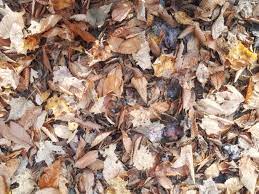
Tinder is the material used to start the fire. It must be dry and easily ignitable. Common types of tinder include dry leaves, needles, grass, newspaper, dryer lint, and even birch bark. Birch bark is an excellent fire starter due to its flammable oils. When selecting tinder, make sure it is dry and crumbles easily.
Kindling
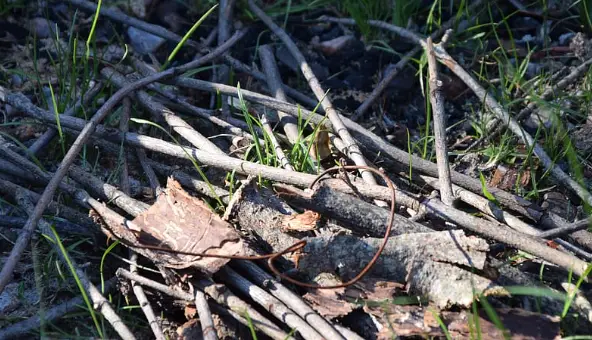
Kindling is the next step after tinder and is used to keep the flame burning. It is small sticks, twigs, or branches that are no thicker than a pencil. Kindling should be dry and easily snapped. Common types of kindling include pines and cedars, which are softwoods that ignite easily.
When selecting kindling, make sure to have various sizes to promote airflow and get the fire started quickly.
Fuel
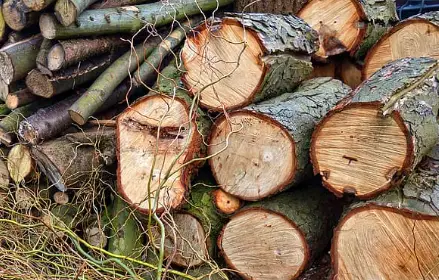
Fuel is the main source of the fire and includes logs, sticks, and branches that are thicker than kindling. Hardwoods such as oak, hickory, and maple are best for fuel as they burn longer and produce more heat. Softwoods such as pine and cedar are also good for fuel but burn faster and produce less heat. When selecting fuel, make sure it is dry and cut to the appropriate size for your fire pit.
It is important to note that when selecting wood types, it is best to use wood from dead trees or branches that have fallen naturally. Avoid cutting live trees or branches as it can harm the environment and may not burn as well. Additionally, never use wood that has been treated, painted, or stained as it can release harmful chemicals when burned.
See Related: 19 Types of Bad Wood To Burn In A Campfire
Building the Fire Structure
When building a campfire, it is important to consider the structure of the fire. Different structures can be used to achieve different goals, such as creating a long-lasting fire or quickly boiling water. Here are some common fire structures to consider:
Teepee
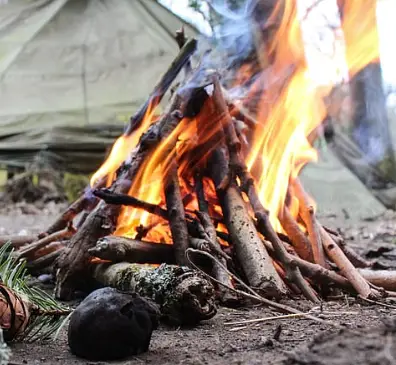
The teepee structure is one of the most common and simple fire structures. It involves creating a cone shape with kindling and then placing the tinder in the center.
As the fire grows, larger pieces of wood can be added to the outside of the teepee. This structure is great for quickly starting a fire and creating a lot of heat.
Log Cabin
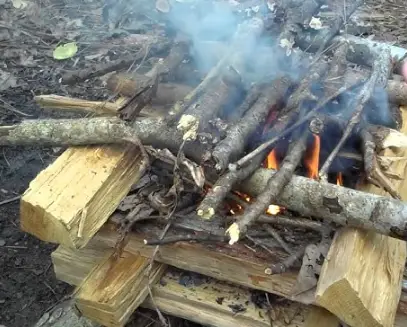
The log cabin structure involves stacking two sets of kindling in a perpendicular pattern, similar to how logs are stacked in a log cabin. The center of the structure is filled with tinder, and as the fire grows, larger pieces of wood can be added to the outside.
This structure is great for creating a long-lasting fire, as the wood burns slowly and steadily.
Lean-To
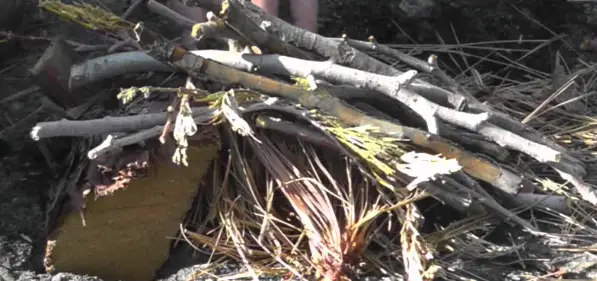
The lean-to structure involves creating a small shelter out of larger pieces of wood and then leaning smaller pieces of kindling against it. The tinder is placed at the base of the structure, and as the fire grows, larger pieces of wood can be added to the shelter.
The lean-to fire is great for creating a fire in windy conditions, as the shelter helps protect the fire from the wind.
Star Fire
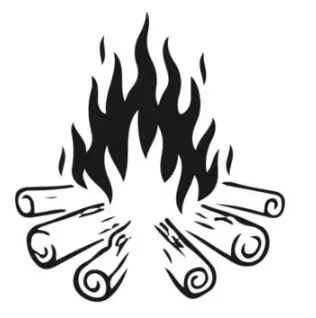
The star fire structure involves creating a star shape with kindling and then placing the tinder in the center. As the fire grows, larger pieces of wood can be added to the outside of the star.
This campfire type is great for creating a fire that radiates heat in all directions.
Upside-Down
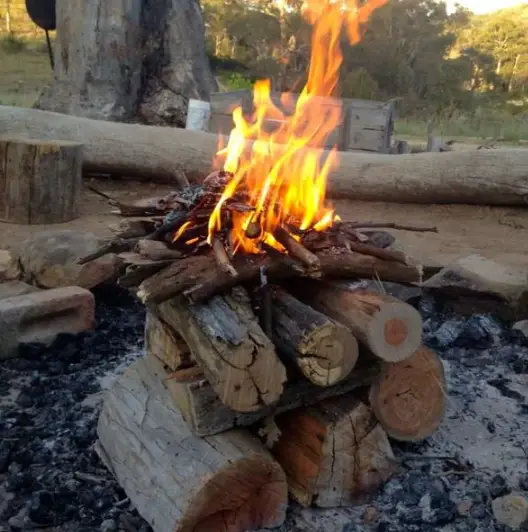
The upside-down structure involves placing the largest pieces of wood on the bottom and then stacking progressively smaller pieces on top. The tinder is placed on top of the stack, and as the fire grows, it burns downwards through the stack.
This fire structure requires little maintenance, as the wood burns slowly and steadily.
Dakota Fire Hole

The Dakota fire hole structure involves digging a hole in the ground and then creating a small tunnel leading to the surface. The tunnel is filled with kindling and tinder, and as the fire grows, larger pieces of wood can be added to the hole.
This structure is great for creating a fire that is easy to control, as the hole helps contain the fire.
Lighting the Campfire
To light the campfire, the camper needs to have a reliable source of ignition. This can be a match, lighter, spark, or fire starter. It is important to note that the camper should always check the local fire restrictions to ensure that they are allowed to light a fire and follow any guidelines or rules.
Once the fire pit is prepared and the wood is stacked, the camper can begin to light the fire. Here are some steps to follow:
- Gather tinder, kindling, and fuel wood. The tinder should be dry and easily combustible, such as dry leaves, grass, or small twigs. The kindling should be slightly larger than the tinder, such as small sticks or branches. The fuel wood should be larger than the kindling, such as logs or split wood.
- Place the tinder in the center of the fire pit. Arrange the kindling around the tinder in a whatever fire structure you desire, leaving a small opening for air to flow.
- Use a match, lighter, or spark to ignite the tinder. If using matches, strike them away from the body and hold them close to the tinder until it catches fire. If using a lighter, hold the flame close to the tinder until it catches fire. If using a spark, hold the spark close to the tinder until it ignites.
See Related: How To Start A Fire Without Matches
- Once the tinder is burning, gently blow on it to add oxygen and help it spread to the kindling. As the kindling catches fire, add more fuel wood to the fire.
- Continue to add fuel wood as needed and adjust the airflow by adding or removing wood to maintain a steady flame. When the fire has burned down to embers, it is ready for cooking or for enjoying the warmth and ambiance of a campfire.
See Related: How To Keep A Campfire Going
Maintaining and Controlling Your Campfire
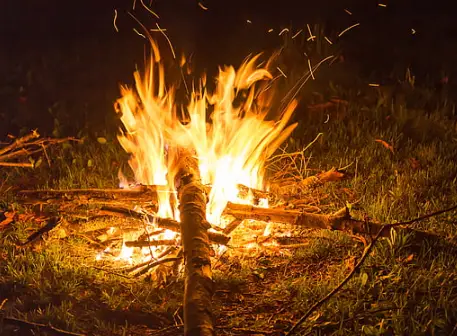
Once the fire is lit, it is important to maintain and control it to ensure that it does not get out of hand. Here are some tips to help you maintain and control your campfire:
- Keep a close eye on the fire at all times, and never leave it unattended.
- Use a shovel to move the logs around and adjust the airflow to control the intensity of the fire.
- Add more fuel logs to the fire to keep it burning, but be careful not to add too much at once, as this can cause the fire to get too hot and out of control.
- As the fire burns down, it will produce embers and hot coals. These can be used to cook food or keep warm. Use a long-handled metal spatula or tongs to move the hot coals around.
- As the fire burns, it will produce ash. Use a shovel to remove any excess ash from the fire pit to prevent it from smothering the fire.
- If the fire gets too hot or out of control, use a bucket of water or sand to extinguish it. Never use dirt or leaves to put out a fire, as these can actually insulate the fire and cause it to smolder.
By following these tips, you can maintain and control your campfire safely and enjoyably. Remember to always practice good fire safety and follow any regulations or guidelines for campfires in your area.
Safety Measures
Starting a campfire is a fun and rewarding activity, but it also comes with some risks. Safety should always be the top priority when building and maintaining a campfire. Here are some important safety measures to keep in mind:
- Choose a safe location: Select a spot that is at least 15 feet away from tents, trees, and other flammable materials. Make sure the area is clear of dry leaves, grass, and debris. Avoid building a fire on windy days.
- Prepare the fire pit: Clear a 10-foot area around the pit. Keep a shovel, bucket of water, and/or sand nearby in case of emergency. If possible, dig a pit that is at least 1 foot deep and surrounded by rocks.
- Use the right materials: Only use dry wood, kindling, and paper to start the fire. Avoid using flammable liquids such as gasoline or lighter fluid.
- Attend to the fire: Never leave a campfire unattended. Keep a close eye on the fire at all times, and make sure children and pets stay away from it.
- Extinguish the fire properly: When it’s time to put out the fire, pour water over the flames and stir the ashes with a shovel. Keep pouring water until the hissing sound stops, and then use the back of your hand to feel for heat. If the ashes are still warm, pour more water and stir again.
Extinguishing the Campfire

Just as important as knowing how to start a campfire is how to extinguish one properly and safely. This helps to prevent forest fires and protects the environment. The following steps should be followed to extinguish the campfire:
- Pour Water: Pour water over the fire, making sure to drown all embers, not just the red ones. Keep pouring until the hissing sound stops. This is the most effective way to extinguish a campfire.
- Stir the Ashes and Embers: Use a shovel to stir the ashes and embers. This helps to expose any hot spots that may still be burning.
- Scrape the Sticks and Logs: Scrape the sticks and logs to remove any embers that may be attached to them.
- Pour More Water: Pour more water over the ashes and embers to make sure everything is wet and cold to the touch.
- Check for Steam: Check for steam rising from the ashes. If you see steam, it means there are still hot spots that need to be extinguished.
- Cover with Sand or Dirt: Cover the ashes and embers with sand or dirt to smother any remaining hot spots. Make sure to mix the sand or dirt with the ashes and embers to ensure that everything is completely covered.
- Check for Ashes: Check for ashes that may have blown away from the fire. If you find any, make sure to extinguish them with water.
Before you go, check out our guide to the best campfire cooking kits to make the most of your campfire experience!
Frequently Asked Questions
Starting a campfire without kindling can be challenging, but it’s not impossible. One way to do it is by using dryer lint, cotton balls, or other highly flammable materials as tinder. You can also use small twigs and branches as kindling. If you’re really struggling, you can try using a fire starter or a commercial fire log to get the fire going.
The best types of wood for campfires are dry, seasoned hardwoods like oak, maple, and hickory. These woods burn hot and long, producing a lot of heat and minimal smoke. Softwoods like pine and spruce are also good options, but they burn faster and produce more smoke. Avoid using green or wet wood, as it will be difficult to light and produce a lot of smoke.
Starting a campfire with wet wood can be challenging, but it’s not impossible. You will need to gather dry kindling and tinder to help get the fire going. You can also try splitting the wet wood into smaller pieces to expose the dry interior.
If you have access to a chainsaw, you can cut off the outer layers of the wet wood to expose the dry wood underneath. Wet wood will produce a lot of smoke, so be mindful of your surroundings and the impact your fire may have on others.

